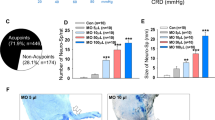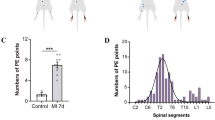Abstract
It has been demonstrated that an important clinical phenomenon often associated with visceral diseases is the referred pain to somatic structures, especially to the body area of homo-segmental innervation. It is interesting that the somatic foci of cardiac referred pain were often and mainly distributed along the heart meridian (HM), whereas the acupoints of HM have been applied to treat cardiac disease since ancient times. The purpose of this study was to investigate the neural relationship between the cardiac referred pain and the heart meridian. Fluorescent triple-labeling was injected into the pericardium, some acupoints of HM and lung meridian (LM, for control). The responses of the left cardiac sympathetic nerve and of the EMG in left HM and LM were electrophysiologically studied, when the electrical stimuli were applied to the acupoints of left HM and to the left cardiac sympathetic nerve. More double-labeled neurons in HM-heart, not in LM-heart, were observed in the ipsilateral dorsal root ganglia of the spinal segments C8-T3. Electric stimulation of the acupoints of left HM was able to elicit more responses of left cardiac sympathetic nerve than that of the LM-acupoints. Electric stimulation of the left cardiac sympathetic nerve resulted in stronger activities of EMG-response in the acupoints of left HM than in LM-acupoints. We conclude that double-labeling study has provided direct evidence for the existence of dichotomizing afferent fibers that supply both the pericardium and HM. Electrophysiological results show that HM is more closely related functionally to heart. These findings provide a possible morphological and physiological explanation for the referred cardiac pain and HM-heart interrelation.
Similar content being viewed by others
References
Cervero, F., Tattersall, J. E. H., Somatic and visceral sensory integration in the thoracic spinal cord, Prog. Brain Res., 1986, 67: 189–205.
Foreman, R. D., Blair, R. W., Animons, W. S., Neural mechanisms of cardiac pain, Prog. Brain Res., 1986, 67: 227–243.
Rong, P. J., Zhu, B., Research on the mechanism of relation between cardiac referred pain and heart meridian, Chinese J. Neuroscience, 2001, 17(suppl.): 269.
Sato, A., Sato, Y., Schmidt, R. F., Modulation of somatocardiac sympathetic reflexes mediated by opioid receptors at the spinal and brainstem level, Exp. Brain Res., 1995, 105: 1–6.
Bahr, R., Blumberg, H., Jänig, W., Do dichotomizing afferent fibres exists which supply visceral organs as well as somatic structures? A contribution to the problem of referred pain, Neurosci. Lett., 1981, 24: 25–28.
Dawson, N. J., Schmid, H., Pierau, Fr. -K., Pre-spinal convergence between thoracic and visceral nerves of the rat, Neurosci. Lett, 1992, 138: 149–152.
Alles, A., Dom, R. M., Peripheral sensory nerve fibers that dichotomize to supply the brachium and the pericardium in the rat: a possible morphological explanation for referred pain? Brain Res., 1985, 342: 382–385.
Selzer, M. E., Spenser, W. A., Convergence and reciprocal inhibition of visceral and cutaneous afferents in the spinal cord, Fed. Proc, 1967, 26: 433–446.
Pomeranz, B., Wall, P. D., Weber, W. V., Cord cells responding to fine myelinated afferents from viscera, muscle and skin, J. Physiol., 1968, 199: 511–532.
Gokin, A. P., Kostyuk, P. G., Preobrazhensky, N. N., Neuronal mechanisms of interactions of high-threshold visceral and somatic afferent influences in spinal cord and medulla, J. Physiol. (Paris), 1977, 73: 319–333.
Foreman, R. D., Hancock, M. B., Willis, W. D., Responses of spinothalamic tract cells in the thoracic spinal cord of the monkey to cutaneous and visceral inputs, Pain, 1981, 11: 149–162.
Zhu, B., Xu, W. D., Acupuncture stimulation-induced analgesia: it involved in segmental and systemic controls, th IBRO World Congress of Neuroscience Jerusalem: JU Press, 1999, 45.
Wang, Z. D., Xu, Y. H., Physiology of Autonomic Nervous System (in Chinese), Beijing: Science Press, 1994, 154–177.
Sato, A., Neural mechanisms of autonomic responses elicited by somatic sensory stimulation, Neurosci. Behav. Physiol., 1997, 21: 610–621.
Zhu, B., Scientific Foundations of Acupuncture-Moxibustion (in Chinese), Qingdao: Qingdao Publishing House, 1998, 446–450.
Giamberardino, M. A., Vecchiet, L., Visceral pain, referred hyperalgesia and outcome: new concepts, Eur. J. Anaethesiol., 1995, 12(suppl. 10): 61–66.
Morrison, J. F., Sato, A., Sato, Y. et al., The influence of afferent inputs from skin and viscera on the activity of the bladder and skeletal muscle surrounding the urethra in the rat, Neurosci. Res., 1995, 23: 195–205.
Tola, M. A., Gutierrez, J. M., Llamazares, O. et al., Muscular spasms associated with a reflex sympathetic dystrophy, Rev. Neurol., 1986, 134: 1278–1280.
Grassi, C., Passatore, M., Spontaneous sympathetic command to skeletal muscles: functional implications, Func. Neurol., 1990, 5: 227–232.
Author information
Authors and Affiliations
Corresponding author
Rights and permissions
About this article
Cite this article
Rong, P., Zhu, B. Mechanism of relation among heart meridian, referred cardiac pain and heart. Sci. China Ser. C.-Life Sci. 45, 538–545 (2002). https://doi.org/10.1360/02yc9059
Received:
Issue Date:
DOI: https://doi.org/10.1360/02yc9059




